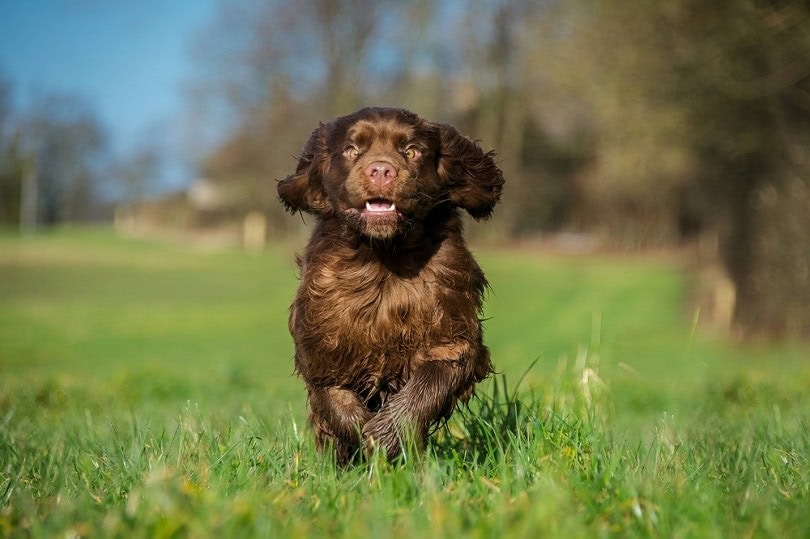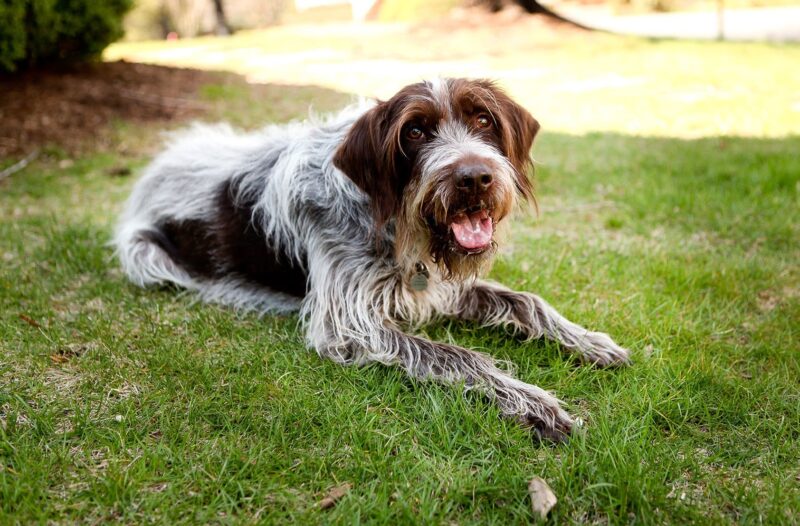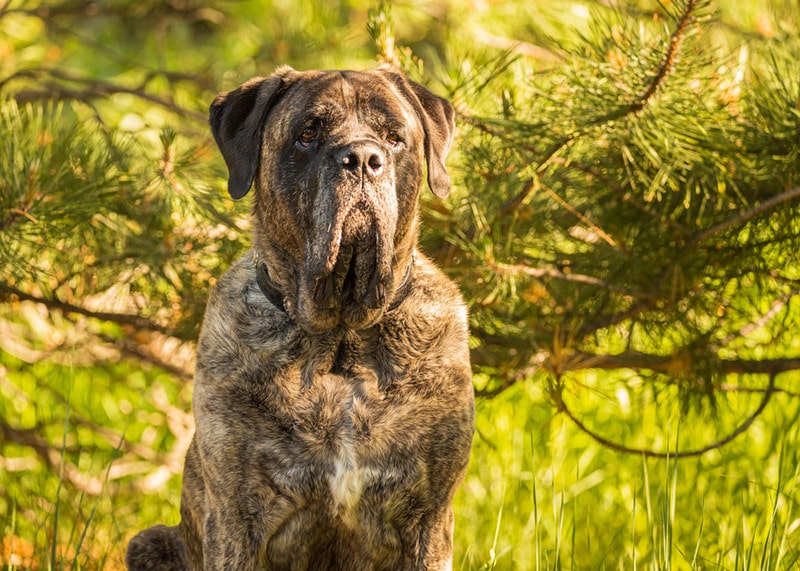Sussex Spaniel Dog Breed Info: Pictures, Personality & Facts

Updated on

| Height: | 15 inches |
| Weight: | 35-44 pounds |
| Lifespan: | 12-15 years |
| Colors: | Liver, golden liver |
| Suitable for: | Rural areas, active lifestyles, hunting tasks |
| Temperament: | Laidback, Easygoing, Mild, Choosy with unfamiliar pets and people |
The Sussex Spaniel isn’t a dog you see every day, but they’re very recognizable when you do. These liver-colored, clownish canines hail from Sussex, England where they accompanied humans on the hunt. Not much has changed over the years. The Sussex still loves the great outdoors, sniffing out critters, and spending time with their crew.
They have been named one of the rarest breeds in present-day England—and are even rarer in the US. Finding one may not be so easy. But if you’re wondering if this breed is the right one for you, read on to find out what sets them apart from all the rest.
Sussex Spaniel Puppies

Sussex Spaniels are a scarce spaniel breed. Depending on where you live, finding a puppy may be a bit of a challenge. But if you find a breeder near you, you should expect to pay a big price. Also, breeders are few and far between. So, there’s a very good chance you’re going to have to travel if you want to add one of these floppy-eared puppies to your home.
The good news is, backyard breeding won’t be a major concern with this breed. So, when you find someone who has Sussex Spaniel pups, they’re likely to be authentic. In any case, always make sure to check the breeder’s reputation and parents’ health before committing. You may get lucky and find a Sussex in a local shelter or rescue. Make sure to call around and check online to see what you can find. Most dogs from these places will be surrendered—and likely adults. But you will pay a fraction of the price with all vetting, spaying or neutering, or other care already in place.
3 Little-Known Facts About the Sussex Spaniel
1. Sussex Spaniels Are Known for “Kippering”
Kippering is when the dog drags their back legs behind them while walking with their front legs. There’s nothing wrong—it’s just one of the Sussex Spaniel’s quirky behaviors.
2. Sussex Spaniels Have a Unique Breed-Specific Color
In addition to their plumes of wispy hair and elongated bodies, Sussex Spaniels have one coat color that ranges ever-so-slightly in shades of golden liver. Some can be a tad lighter or darker, but these variations are mild at best.
3. Sussex Spaniels Faced Extinction After World War II
The Sussex Spaniel had a few brush encounters with breed extinction, but none greater than post-World War II. This breed almost disappeared entirely in England. They have never quite regained their once-abundant numbers, remaining an extremely rare breed all over the world.
Temperament & Intelligence of the Sussex Spaniel 🧠
Sussex Spaniels are considered soft personalities, which means they are very easygoing, but they can be stubborn, too. The earlier you train these dogs, the more receptive they will be of future learning. They truly do have a bleeding heart for their humans, so their want-to-please may outweigh their hard-headedness from time to time.
They love hanging out with their families for cuddles, but if you want to make your Sussex learn new tricks—they’ll need a little motivation. Positive reinforcement, usually in the form of a good treat, is the best tactic to train them. A Sussex will never turn down a tasty morsel.
This breed has hunted for generations. It’s something that is hardwired in their DNA. Because of this, agility and field training comes very naturally to them. They thrive being in nature, even when they aren’t hunting—so they make awesome hiking buddies, too.
Are These Dogs Good for Families? 🏡
Sussex Spaniels are devoted and loyal dogs to every member of the household. They love their families so much that they can be a little overly protective of who gets close to them. Known for being slightly aloof, this breed will keenly watch newcomers—ready to intervene at any time if they need to.
Sussex Spaniels adore children, but they may do best with older kids unless they are raised together from puppyhood. They are pretty relaxed, so the chaos that little ones can bring may overwhelm them a bit. Each dog is different, so your Sussex may take to tiny tots better than some others. Always supervise playtime, in any regard.
This breed is also the most vocal of all the other spaniel variations. So, if you live near others, like in an apartment or condo, your neighbors may not take kindly to the excessive barking. Enforcing healthy barking behavior may work, but remember that this is simply ingrained in the breed.
Does This Breed Get Along with Other Pets? 🐶 😽
The earlier you can expose your Sussex to other animals—the better. They can make superb companions for other dogs and even cats. But socializing your puppy is the best way to ensure they will thrive with other pets.
Sussex Spaniels can be territorial with unfamiliar canines. While this isn’t necessarily common spaniel behavior, this breed is the most likely to act out in aggression if they think another pooch is intruding on their hearth and home.
Also, because of their prey drive, you shouldn’t trust them alone with smaller pets—like birds or rodents. Instinctually, they may act without understanding that the animal is a friend, not food. For the same reason, you should always have your Sussex in a secured yard or on a leash—especially if you live in the city or suburbs. They can get distracted easily by the neighborhood critters and wander away before you realize. However, in rural areas, you can likely trust this dog to roam at their own leisure.

Things to Know When Owning a Sussex Spaniel:
Food & Diet Requirements 🦴
Sussex Spaniels have robust appetites and will eat pretty much anytime you allow them to do so. Because of their voracious eating habits, they need a controlled diet full of antioxidants, protein, and fatty acids.
Each dog will be different in structure, weight, and activity level. These dogs do best with a high-quality dry kibble diet to meet their dietary needs. Generally speaking, a full-grown Sussex will need roughly 2 cups of dry kibble per day—though you should always follow the feeding chart on the back of the bag.
Offer wet food as a topper if you wish, but remember these dogs are prone to weight gain. So, moderation is key for any damp dish.
For snacking, offer low-calorie snacks like wholesome fruits, veggies, and grains.
Exercise 🐕
Sussex Spaniels need a moderate to low amount of exercise per day. Sometimes, they need a little motivation to get moving—these dogs like naps, snacks, and relaxing. So, getting them out of the house lets them burn off a little energy and keep a healthy weight.
Since these dogs love the great outdoors, you won’t have to coax them out while they put up a fight. Sussex Spaniels love a good adventure, happily accompanying you on walks, hikes, and explorations. They’re also terrific swimmers who will want to splash in the water any chance they get.
In total, Sussex Spaniels require about 20 to 30 minutes of activity per day.
Training 🦮
Sussex Spaniels are very smart, so they can pick up on training easily—if they’re in the mood. These dogs can be quite picky about where and when they want to learn, and just how much they’ll retain.
They do not respond to harsh punishments or mistreatment—nor will they forget it. They have exceptional memories, so make sure you’re giving them good ones. The Sussex does best with repetitive, consistent training and reward.
Beginning training in the very early puppy days reaps the best results. These dogs are hunters, so getting them ready for those types of commands around six months of age helps to best shape their abilities.
Because of their bodies developing, agility training should happen after the bulk of their growing finishes. These dogs are slow to grow, and it can hurt more than help to engage in these actions too early.

Grooming ✂️
Sussex Spaniels are short-legged, long-bodied dogs with liver-colored fur. They’re moderate shredders who benefit from regular brushing. But they don’t require haircuts or extensive coat care, so things should go smoothly in the grooming department.
Coats of neutered males change to a fuzzy, cotton-like texture, which can make combing a challenge. To prevent matting and knots, brush up to three times a week—or as needed.
Trimming the legs can be helpful so they can maintain traction under their feet. Sometimes the frills of hair on their legs can grow too long and get in the way. There is no need to shave the fur of a Sussex Spaniel. When you do, the coat grows back very slowly—so it’s best to avoid that altogether.
Health and Conditions ❤️
Sussex Spaniels are generally healthy dogs with no major genetic concerns. However, there are certain problems found in the breed more frequently than others. Regular veterinary checkups allow you to get ahead of any potential issues, tackling them as they come.
- Dental issues
- Whelping troubles
- Patent ductus arteriosus
- Hypothyroidism
- Dental issues—this dog is susceptible to periodontal disease. You can avoid this condition with regular brushing, offering chew toys, and feeding your Sussex dry kibble.
- Whelping troubles—this breed is more likely than some others to have issues with birthing puppies, leading to a c-section for delivery.
- Patent ductus arteriosus—this is a genetic heart issue where the fetal blood vessel of the heart doesn’t close completely. If it’s left untreated, it can cause sudden heart failure.
- Hypothyroidism—this condition happens when the thyroid gland in their neck produces too little of the hormone. It leads to weight gain, hair loss, and other bodily symptoms.
Male vs. Female
Both male and female Sussex Spaniels are wonderful companion animals with a vibrant personality. This laidback dog is gentle, happy, and loving—regardless of being male or female. However, there will be minor differences between the male and female Sussex Spaniels that are noteworthy.
Males tend to be slightly larger than females. They also have a higher inclination to bark if they hear a noise or see a passerby—although both genders are highly vocal.
Females are smaller than males. They tend to be a bit more difficult to house train, picking up the concept slightly slower than their male counterparts. Females may also have whelping trouble, so if you plan to breed, know there could be higher vet costs associated with pregnancy care.
Of course, none of these factors should be deal-breakers. Always meet the puppies to access your connection. An individual personality is more important than gender.

Final Thoughts
Summing up, if you want a laid back dog who’s also protective—the Sussex Spaniel may be a perfect fit. Keep in mind these dogs are very vocal and will bark whenever they feel they need to. Aside from their own loud howls, they like a slow-paced life free of commotion. So, if you’re the type to take a relaxed approach to life, they will surely follow suit.
Does the Sussex sound like a soulmate? If they do, consider checking local shelters to give a pup a second chance before opting for a puppy.
See also:
- Golden Mountain Dog Mixed Breed Info, Pictures, Facts, & Traits
- Saint Pyrenees (Great Pyrenees & Saint Bernard Mix): Info, Pictures, Characteristics & Facts
Featured image credit: Vera Reva, Shutterstock













